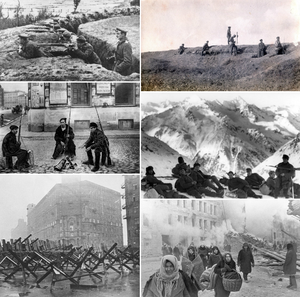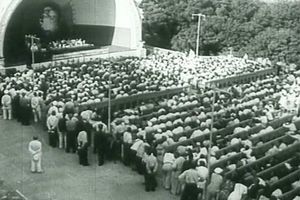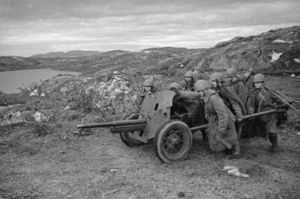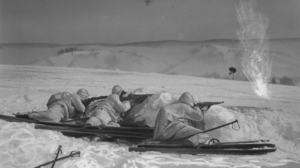Difference between revisions of "Faichani Civil War"
(→Faichani War: pictures) |
m |
||
| Line 79: | Line 79: | ||
[[File:Soptenesetankfcw.jpg|thumb|right|Soptenese tank participated in the southwestern invasion]] | [[File:Soptenesetankfcw.jpg|thumb|right|Soptenese tank participated in the southwestern invasion]] | ||
[[File:Announcementofthewar.jpg|thumb|left|Residents of [[Músoxubuty]] listen to the announcement of the outbreak of war. October | [[File:Announcementofthewar.jpg|thumb|left|Residents of [[Músoxubuty]] listen to the announcement of the outbreak of war. October 17, 1935]] | ||
The [[Faichani Unification Military Government|Unification Government]] forces quickly moved south, [[Soptemia]] launched an invasion of the southwestern regions of the [[Transrolovian Communes]]. In this region, large forces of the [[Transrolovian Communes]] began to accumulate. This place was important, since aid from [[Vanosha]] came from here. At the end of November 1935, this region was cut off from the main part of the [[Transrolovian Communes]]. About a million people were locked in an encirclement and gradually squeezed by enemy forces advancing from the north and east. They continued to resist with aid from [[Vanosha]]. | The [[Faichani Unification Military Government|Unification Government]] forces quickly moved south, [[Soptemia]] launched an invasion of the southwestern regions of the [[Transrolovian Communes]]. In this region, large forces of the [[Transrolovian Communes]] began to accumulate. This place was important, since aid from [[Vanosha]] came from here. At the end of November 1935, this region was cut off from the main part of the [[Transrolovian Communes]]. About a million people were locked in an encirclement and gradually squeezed by enemy forces advancing from the north and east. They continued to resist with aid from [[Vanosha]]. | ||
Revision as of 11:33, 12 February 2023
| Faichani Civil War | |||||||||
|---|---|---|---|---|---|---|---|---|---|
 Clockwise from top left:
| |||||||||
| |||||||||
| Belligerents | |||||||||
|
Provided support to various sides: TBD | |||||||||
| Commanders and leaders | |||||||||
|
| |||||||||
| Strength | |||||||||
| a lot of people | |||||||||
| Casualties and losses | |||||||||
| a lot of people | |||||||||
The Faichani Civil War (Tyunyi: Çú Mózekny Féyçasagekny; Chú Mózekny Féychasagekny [ˈt͡ɕu ˈmˠɔʂɛkn̪ʲ ˈfˠɛjt͡ɕas̪ˠagɛkn̪ʲ]) is a series of military conflicts in former Faichani Empire from 8 August 1918 to 14 July 1939. In Faichan it is known as the Great People's War (Tyunyi: Çú Slutógusag Mózosag; Chú Slutógusag Mózosag [ˈt͡ɕu s̪ˠɫ̪uˈt̪ˠɔgus̪ˠag ˈmˠɔʂɔs̪ˠag]).
Background
Dissatisfaction with the monarchy
Growth of radical movements
First Faichani Revolution
Abolition of slavery and creation of Parliament
Assassination of Gvéxer IV
August Revolution
Faichani Warlord Era
First period of the war (1918–1923)
First battles of the war
First Battle of Nlítyekeg
Invasion from the south
Foeian Campaign
Final breakup
Second period of the war (1923–1927)
Left uprising
Second Battle of Nlítyekeg
Fall of most warlords
Third period of the war (1927–1930)
Last unification wars
Republican Split
Faichani-Foeian War
Foeian offensive
The failure of the offensive
Encirclements near Falkty and Zaremzsag
Counteroffensive, surrender of Buwtu
Faichani War
Background
After the stunning victory over Fukota, the Transrolovian Communes were at the height of their military power. In the north, the remaining military forces, represented by the Faichani Empire, the Faichani Republic, and the Red-Green Army of Liberation, decided to temporarily unite into a single Faichani Unification Military Government. Its goal was the destruction of the Transrolovian Communes, and after integration into one of the sides. The Unification Government made alliance pacts with Soptemia and Fukota to attack the Transrolovian Communes together at the same time. Soptemia was afraid of a possible Kúúlist revolution in the country, sponsored by the Transrolovian Communes, and therefore agreed. Fukota, in turn, simply wanted to take revenge, regain the territories lost during the Faichani-Foeian War, and, if possible, acquire new ones. The Unification Government also entered into treaties with other states that promised military support in case of war. The Transrolovian Communes received support from Vanosha, although in much smaller numbers due to the Vanoshan Famine of 1928-1934. The invasion plan was named Operation Great Mountains.
War was close. At the October 1935, The divisions of the Unification Government were stationed along the border in full force and were ready to attack, the divisions of the Transrolovian Communes were only moving towards the border and by the beginning of the war a little more than half were on the border.
First period of the war (1935)
On the evening of October 16, 1935, the generals lined up their soldiers in ranks and read to them the following text:
Right now you are standing at the border, which should not be. Our goal is to destroy the enemy, the existence of pure Faichan is now in your hands! We must wage war harshly and cruelly so that nothing remains of the enemy, and the thoughts of the people of the occupied territories are cleared. Get ready, the purification campaign will begin in the morning!
After the speech, numerous saboteurs reported the beginning of the war at dawn. The movement of divisions to the borders accelerated, but it was already too late. Those military units that were on the borders were transferred to the mode of military readiness. With the beginning of dawn, numerous bombers flew from the airfields to the border. Their goal was to bomb the military installations and the cities themselves of the Transrolovian Communes. The sky of numerous cities was filled with planes, and a few minutes later bombs rained down on them. With their explosions, the war began.

The Unification Government forces quickly moved south, Soptemia launched an invasion of the southwestern regions of the Transrolovian Communes. In this region, large forces of the Transrolovian Communes began to accumulate. This place was important, since aid from Vanosha came from here. At the end of November 1935, this region was cut off from the main part of the Transrolovian Communes. About a million people were locked in an encirclement and gradually squeezed by enemy forces advancing from the north and east. They continued to resist with aid from Vanosha.
On December 6, 1935, Fukota crossed the border. Troops were quickly moved into the almost empty border. During the transfer of troops, the border near the cities of Búxuty and Vlánotyekeg was greatly weakened, which led to a strong push back and encirclement of about three hundred thousand soldiers near the cities of Tozólseb and Byúsag. On the border with Fukota, numerical superiority led to the encirclement of some newly arrived forces near the cities of Rólbosyefrytyekeg and Lyúsagoz. The forces of the Unification Government and its allies were not far from the capital of Faichan – Nlítyekeg, and were approaching the second largest city of Faichan – Rólboty.
Second period of the war (1936–1937)
With the onset of winter, the front stopped. Strong colds began and in many places the forces were approximately equal. However, no one was going to give up or stop, everyone was waiting for spring and preparing plans for it. The only place where the front was constantly moving was the southwestern encirclement.
Third Battle of Nlítyekeg
With the beginning of spring, a large-scale operation began to take Nlítyekeg, called Operation Waterfall. On March 27, 1936, the cities of Súspyentyekeg and Rosyarúty were taken. The way to Nlítyekeg was opened, the Third Battle of Nlítyekeg began.
On April 4, Decree No. 116 was issued, also known as "Not a Single Street to Give Back!". According to the decree, if the situation was not doomed, then it was forbidden to retreat. On June 16, the first urban battles began, they fought for every street, for every house. It was necessary to defend the city. The city was overflowing with the corpses of soldiers and destroyed military equipment.
On September 20, the last forces of the Unification Government were driven out of the city. And the fighting continued already for the region. By November, the front in this direction had stopped.
Battle of Rólboty
On July 16, the forces of the Unification Government approached Rólboty. The city was an important target not only because of its size, but also because it was the hotbed of the Kúúlist revolution throughout Faichan.
The capture of the city was one of the parts of the Operation Lock, according to which, after the capture of Rólboty, the army in these directions was to move to the northeast in order to close the ring and surround Nlítyekeg. The battles for the city were fought with even more ferocity and tenacity than in Nlítyekeg. Everyone understood the importance of the city, however, with each passing day, the strength of the Unification Government was getting weaker and weaker. The reason for this was the forces of the Transrolovian Communes blocked in the south-west and the army in the Nlítyekeg direction, which required more and more new soldiers.
Going to the counteroffensive
With the onset of winter, the front stopped in many places. However, only for a short time. The plans for Operations Red Flag and The Last Khan were prepared. According to Operation Red Flag, the divisions of the Unification Government were attacked by the army of the Transrolovian Communes north and south of Rólboty, after which they connected with rapid attacks west of the city, leaving many soldiers of the enemy army locked up near the city. Operation The Last Khan involved attacks on the forces of the Unification Government and Fukota in the north, and after the launch of a large-scale counteroffensive on Fukota. The execution of all these operations was supposed to be carried out in winter, when the enemy considered large-scale attacks impossible.
On December 18, 1937, the execution of Operation Red Flag began. Enemy forces south of Mózotyekeg were attacked. Within a few days, the enemy was driven back to Oníty, then an attack began from the south. On December 23, the forces of the southern army entered Kyadúty and headed north to meet with the northern army. On December 28, the forces of both armies met, leaving almost a third of the army of the Unification Government surrounded near Rólboty. Gradually, surrounded by soldiers began to die of cold and hunger, and in mid-January, they capitulated. The troops moved to the east, towards the army, surrounded by already 2 years, and to the north.
Operation Last Khan began at the end of December. Most of the attacks were directed at Foeian forces, due to the fact that their army was much weaker and less equipped in winter. By mid-January, Foeian forces were pushed back to Nígosag and Púhty, but further advance was halted due to the difficulty of passing through the mountains. As part of the operation, the army of the Unification Government was pushed back to Tozólseb and Kócty.
Third period of the war (1938)
In February 1938, the encircled army of the southeast merged with the main forces of the Transrolovian Communes. For Soptemia, there was a real threat of invasion and the establishment of a Kúúlist regime, therefore in March it withdrew from the war, declaring neutrality.
Capture of Bód
Faichan was divided into two: the north of the Unification Government and the south of the Transrolovian Communes. The latter wanted to change this, and for this, Operation Mammoth was prepared. According to the operation, the armies moved along the line of cities Tozólseb-Byúsag-Búxuty-Syáty-Bód and gradually expanded along this line. In March 1938, the execution of the operation began. Deprived of the support of Fukota and Soptemia, they basically only retreated. On April 16, 1938, Bód was taken and there was a threat that the forces of the Unification Government would be divided into two parts. An attack on the line began, however, it was not possible to cut it and by the beginning of winter, it only expanded more.
Fourth period of the war (1939)
In the winter of 1939, attacks began in the eastern direction, due to poor supplies and cold weather, it was possible to push the forces of the Unification Government to Múnanty. There was an encirclement of forces and their defeat and the beginning of the campaign to Sírbibug.
Decay of the Unification Government

At the end of February, the Unification Government split into Eastern and Western, which acted absolutely independently of each other. On March 20, Sírbibug was taken and from there and from Bód the offense on Sísirfuty began. The goal was to completely isolate the Eastern Unification Government from the outside world.
Encirclement of Vyádyugobug Region
In early April, the plan for Operation Isolation was created. According to it, the armies moved along the northern border and from there gradually moved south. On April 20, the troops advanced towards Sísirfuty, on May 11 a Battle of Sísirfuty took place, the result of which was the victory of the forces of the Transrolovian Communes. The encirclement of the capital of the Eastern Unification Government - Vyádyugobug began.
Battle of Rólboxuty
At the end of April, preparations for Operation Liberator began. Its goal was to take the main cities of the Western Unification Government and force it to capitulate. From Klúmloty and Oníty, the army of the Transrolovian Communes moved towards Ímustyekeg, from here they wanted to attack Xúdoty and Rólboxuty, the capital of the Eastern Unification Government. In May, Rólboxuty was taken and an offensive began to the north along the entire front. On May 20, the Western Unification Government capitulated.
Path to Victory Day
On June 11, a full-scale attack on the capital of the remnants of the Unification Government began. It happened as part of Operation Flag to Earth. On July 14, 1939, the capture of the city was symbolically confirmed by tearing down the flag of the Unification Government and replacing it with the flag of the Transrolovian Communes and the flag of the division that stormed the Government building. On the same day the capitulation of the Unification Government was signed.

